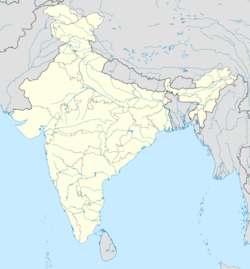Bharmour
This article needs additional citations for verification. (May 2025) |
Bharmour | |
|---|---|
Village | |
 Bharmour, view from the top | |
| Coordinates: 32°26′34″N 76°31′58″E / 32.4428°N 76.5329°E | |
| Country | |
| State | Himachal Pradesh |
| District | Chamba |
| Population (2011)[1] | |
• Total | 1,374 |
| Language | |
| • Official | Hindi[2] |
| • Additional official | Sanskrit[3] |
| Time zone | UTC+5:30 (IST) |
| Sex ratio | 916 ♂/♀ |
Bharmour is a village in the Indian state of Himachal Pradesh. Located in Chamba district, it is known for the Chaurasi Temple complex. Bharmour is associated with the historical Brahampura, the capital of Chamba State. Bharmour is also a constituent assembly for the Himachal Pradesh Vidhan Sabha.
History
[edit]The region was settled by Kolian tribes around 2nd century BCE. In 6th century AD, King Meru founded the Chamba State and Brahampura served as its capital. In 920 CE, Raja Sahil Varman shifted the capital of the Chamba State to Chamba.[1][4]
Geography
[edit]Bharmour is located about 60kms to the south-east of Chamba.
Demographics
[edit]As of 2011 Indian Census, Bharmour had a total population of 1,374, of which 717 were males and 657 were females. Population within the age group of 0 to 6 years was 168. The effective literacy rate of 7+ population of Bharmour was 86.15 %, of which male literacy rate was 92.15% and female literacy rate was 79.73 %. The Scheduled Castes and Scheduled Tribes population was 203 and 961 respectively. Bharmour had 319 households in 2011.[1]: 236
Notable places
[edit]Chaurasi Temple
[edit]

Chaurasi Temple is located in the centre of Bharmour town. There are 84 shrines built in the periphery of Chaurasi Temple.[citation needed] "Chaurasi" is the Hindi word for the number eighty-four. The temple complex was built approximately the 7th century.[citation needed]
Major temples in the complex
[edit]
- Lakshana Devi Temple (Lakhna Devi/Bhadrakali): The temple of Lakshana Devi is the oldest temple at Chaurasi Temple, Bharmour.[citation needed] It is dedicated to Durga in her aspect of four-armed Mahishasuramardini, the slayer of the buffalo-demon Mahishasura. The carvings include themes of Shaivism and Vaishnavism.[5][6][7]
- Manimahesh (Shiva) Temple: the Manimahesh Temple which stands in the centre of the Chaurasi Temple, is the main temple, enshrining a huge Shiva linga.
- Narsingh (Narasimha) Temple: Narasimha (Sanskrit: Narsingh) or Nrusimha, also spelled as Narasingh whose name literally translates from Sanskrit as "Man-lion".
- Lord Nandi Bull Temple: the life-size metal bull Nandi, locally known as Nandigan with the broken ear and tail, can be seen standing in a modern shed in front of Manimahesh temple.
- Dharmeshvar Mahadev (Dharamraj) Temple: Dharamraj, known as Dharmeshvar Mahadev, is in the northern corner of Chaurasi
- Ganesh or Ganpati Temple: the Ganesha temple is situated near the entrance of the Chaurasi Temple.
References
[edit]- ^ a b c "Census of India 2011 - Himachal Pradesh" (PDF). Office of the Registrar General & Census Commissioner, India. Retrieved 18 May 2025.
- ^ "52nd Report of the Commissioner for Linguistic Minorities in India" (PDF). nclm.nic.in. Ministry of Minority Affairs. Archived from the original (PDF) on 25 May 2017. Retrieved 20 December 2018.
- ^ Chauhan, Pratibha (17 February 2019). "Bill to make Sanskrit second official language of HP passed". The Tribune. Shimla. Archived from the original on 18 February 2019. Retrieved 18 May 2025.
- ^ Basu, Ashok Ranjan (1985). Tribal Development Programmes and Administration in India: With Special Reference to Himachal Pradesh. National Book Organisation. p. 58. ISBN 978-81-85135-09-0.
- ^ Hermann Goetz (1955). The Early Wooden Temples of Chamba. E. J. Brill. pp. 14, 59–65, 75–83.
- ^ Omacanda Hāṇḍā (2001). Temple Architecture of the Western Himalaya: Wooden Temples. Indus. pp. 138–151. ISBN 978-81-7387-115-3.
- ^ Ronald M. Bernier (1997). Himalayan Architecture. Fairleigh Dickinson University Press. pp. 139–142. ISBN 978-0-8386-3602-2.
Further reading
[edit]- Antiquities of the Chamba State by J. Ph. Vogel (1911)
- The early wooden temples of Chamba by Hermann Goetz (1955)

